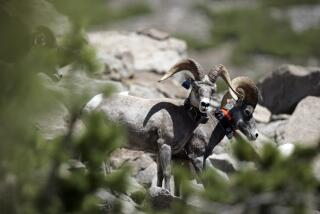Where the Antelope Played : THE LIFE AND TIMES OF THE ANTELOPE VALLEY’S NAMESAKE
- Share via
Long before the creosote bushes and sagebrush were bulldozed to make way for cookie-cutter tract homes, pronghorn antelope once roamed freely in north Los Angeles County.
The cinnamon-colored animal was so prevalent that the region was dubbed Antelope Valley, a name that still remains despite the virtual absence of the pronghorn and the fact that it is not even a true antelope.
Although there are no definitive records of the peak numbers for the animal in the Antelope Valley, a count done for sport by cowboys in the 1880s found there to be 7,000 of the pronghorn.
A variety of factors are believed to have contributed to their demise. As the area was settled, fences reduced the pronghorns’ rangeland and interrupted migration routes. Train tracks, which the high-strung animals were afraid to cross, had a similar impact. Hunters, weather and competition with animals for food and water also likely played a role.
Anecdotal evidence indicates that pronghorn were still running wild, in greatly diminished numbers, in the Antelope Valley until the late 1940s.
Nearly four decades later, the once-absent pronghorn were brought back to the region by the California Department of Fish and Game as part of a statewide effort to return them to historic ranges and expand their population.
In 1985 and 1987, about 100 pronghorn were placed on the Tejon Ranch in the west Antelope Valley, where the small herd now numbers as many as 200.
Fewer in Number
Despite their versatility, only a fraction of the once-prevalent pronghorn remain in North America. At the time Lewis and Clark crossed the continent, there were an estimated 60 million pronghorn.
Just 100 years later, the pronghorn was in danger of extinction when indiscriminate hunting, together with displacement of habitat, left just 13,000 pronghorn on this continent by the turn of the century. Over the past 95 years, the population has rebounded, growing to 1 million.
Pronghorn ( Antilocapra americana )
* Characteristics: Light-colored, with a white belly and white neck markings, it sheds its horns annually. When a pronghorn becomes alarmed or excited, the three-inch-long white hair on its rump fluffs up like a giant cotton ball, signaling to others in the herd that something is amiss.
* Size: Generally smaller than deer, weighing between 80 and 140 pounds.
* Predators: Man, coyotes, mountain lions and eagles.
* Habitat: Unlike deer and elk, which like to be in brushy or forested areas, pronghorn prefer wide-open country and rolling plains so that they can easily see and then flee their enemies.
* Other traits: A graceful animal, the pronghorn is intensely curious. It is a trait that hunters have used to their advantage. The waving of flags has been enough to beckon the curious pronghorn close, making them an easy target.
One of the Swiftest
The pronghorn has the ability to run at speeds of 45 m.p.h., making it the fastest animal in North America and the world’s second fastest, behind only the cheetah. Pronghorn can maintain speeds of 25 to 30 m.p.h. over long distances and it uses this, along with its keen eyesight, as a defense against predators.
The Pronghorn’s Home
The pronghorn, which has existed about 20 million years, is found in every state west of the Mississippi, with different subspecies residing as far north as Canada and as far south as Mexico. A highly adaptive animal, pronghorn are found living at sea level and at elevations as high as 11,000 feet.
Wyoming is home to more than half of North America’s pronghorn, with an estimated 500,000 to 600,000 of the swift-moving animals roaming that state’s grasslands.
The only historical pronghorn habitats that have been continually occupied in California are Modoc, Lassen and adjoining counties, where today there are as many as 6,000 to 8,000 pronghorn. Decreased hunting, together with improved rangelands, have allowed the population to reach its highest level this century.
Sources: City of Lancaster Museum / Art Gallery; Laura Colton, California Department of Fish and Game pronghorn antelope program coordinator; Jim D. Yoakum, retired wildlife biologist; Bob Barnes, L. A. Zoo curator of mammals; In Love With Life in Lancaster by Grace Graham Pickus; “Antelope Valley History: The Journal of the West Antelope Valley Historical Society.”
Researched by SHARON MOESER / Los Angeles Times
More to Read
Sign up for Essential California
The most important California stories and recommendations in your inbox every morning.
You may occasionally receive promotional content from the Los Angeles Times.













